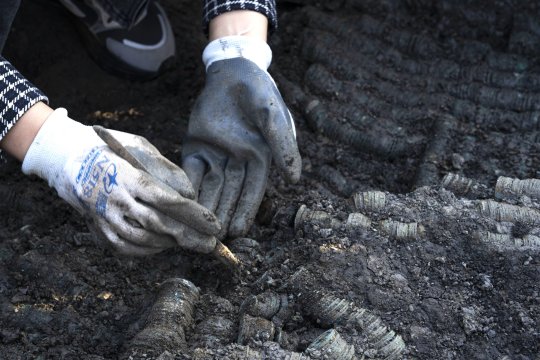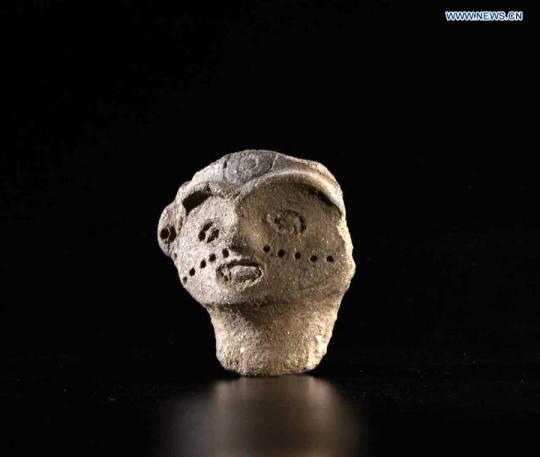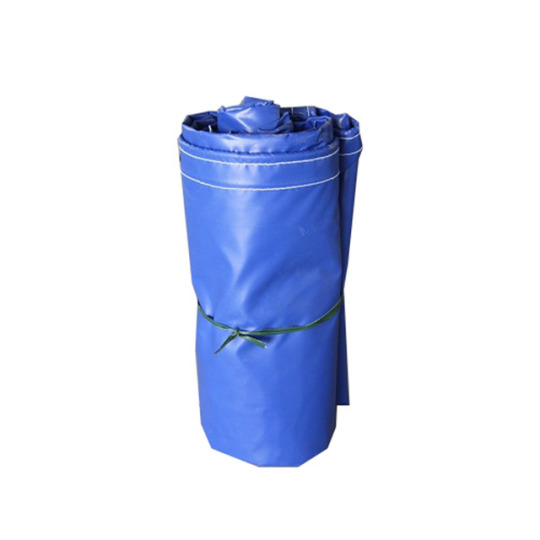#Shuangdun
Photo



1.5 Tons of Ancient Bronze Coins Found in China
A massive hoard of 1.5 tons of bronze coins dating to the Tang (618-907) and Song (960-1279) dynasties has been unearthed in the village of Shuangdun in eastern China’s Jiangsu province. The coins were strong together with straw ropes and arranged in tidy stacks.
The uncovered coins were well-preserved, and most of them had clear inscriptions, suggesting important value for further research.
In ancient China, such hoards were often buried in the ground so as to preserve precious porcelain, coins, metal tools, and other valuables, said the researchers.
Seventy wells were also found around the coin hoard, which was near the battle frontline of the Song and Jin troops, making the researchers wonder whether the excavation site belonged to a hutted camp.
Most of the coins in the hoard are from the Song dynasty wens. Bronze wens were the common currency of the period until a severe copper shortage forced the Southern Song dynasty (1127-1279) to issue coins of lower quality and value. Iron was hard to mint and rusted too easily once in circulation. Due to the scarcity of bronze coinage, the government was forced to cut military wages in half in 1161, ultimately leading to the emergence of paper money. In 1170, the state began to require that half of all taxes be paid with Huizi paper currency stepped into the breach.
#1.5 Tons of Ancient Bronze Coins Found in China#Shuangdun#china’s jiangsu province#tang dynasty#song dynasty#coins#bronze coins#coin hoard#collectable coins#treasure#ancient artifacts#archeology#archeolgst#history#history news#ancient history#ancient culture#ancient civilizations#ancient china#chinese history
85 notes
·
View notes
Text
Coins from the Tang (618-907) and Song (960-1279) dynasties has been discovered in Jiangsu Province, east China. The coins were strong together with straw ropes and arranged in tidy stacks.
The underground remains were unearthed in Shuangdun Village, Jianhu County of Yancheng City. The pit mouth of the hoard was square, 1.63 meters long, 1.58 meters wide, and 0.5 meters deep. Bronze coins connected in series with straw ropes were neatly layered and paved inside. Most were from the Song Dynasty.
The coin hoard was near the battle frontline of the Song and Jin troops, making the researchers wonder whether the excavation site belonged to a hutted camp.
#history#archeology#archeologicalsite#discovery#ancient china#ancient chinese#bronze coins#tang dynasty#song dynasty
0 notes
Text
Mysterious female pottery face sends 7,300 year-old smile

HEFEI -- A mysterious piece of pottery shaped as a female head sends a smile from 7,300 years ago, as its host museum in east China's Anhui Province starts a global naming bid for the ancient relic.
Ji Yong, curator of the Anhui Bengbu Museum in the city of Bengbu, said the statue was among 600 pieces of pottery unearthed from a New Stone Age site at Shuangdun village in Anhui in 1985.
Using Carbon 14 technology, the relics were dated back to 7,300 years ago.
However, it is still unknown what the statue was used for and why it was the only one of its kind, with the rest being utensils bearing inscriptions of various symbols believed to be origins of Chinese characters.
The statue, made with earth containing mica powder and quartz, is a flickering tattooed female face with marks emblazoned on her forehead that archaeologists have judged as a sun symbol. Read more.
213 notes
·
View notes
Photo

Polyester oil wax tarpaulin[sornyang]Zhejiang Shuangdun Textile
http://www.textile-sd.com/china/polyester-oil-wax-tarpaulin
Polyester oil wax tarpaulin is a high-strength polyester mesh as the base fabric, anti-mildew agent, anti-aging agent, antistatic agent and other chemical additives, made by high temperature plastic.
Company:Zhejiang Shuangdun Textile Technology Co.,Ltd.
Phone:+86-574-88661909 /+86 13967855556
Email:[email protected]
����(4
0 notes